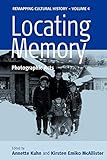Locating Memory : Photographic Acts / ed. by Annette Kuhn, Kirsten Emiko McAllister.
Material type: TextSeries: Remapping Cultural History ; 4Publisher: New York ; Oxford : Berghahn Books, [2006]Copyright date: ©2006Description: 1 online resource (300 p.)Content type:
TextSeries: Remapping Cultural History ; 4Publisher: New York ; Oxford : Berghahn Books, [2006]Copyright date: ©2006Description: 1 online resource (300 p.)Content type: - 9781845452278
- 9781782381990
- 770 22
- TR183 .L633 2008
- online - DeGruyter
| Item type | Current library | Call number | URL | Status | Notes | Barcode | |
|---|---|---|---|---|---|---|---|
 eBook
eBook
|
Biblioteca "Angelicum" Pont. Univ. S.Tommaso d'Aquino Nuvola online | online - DeGruyter (Browse shelf(Opens below)) | Online access | Not for loan (Accesso limitato) | Accesso per gli utenti autorizzati / Access for authorized users | (dgr)9781782381990 |
Frontmatter -- Contents -- List of Illustrations -- Acknowledgements -- 1 Locating Memory: Photographic Acts – An Introduction -- Part I: Identities -- 2 Re-placing History: Critiquing the Colonial Gaze through Photographic Works by Jeffrey Thomas and Greg Staats -- 3 Photography, ‘Englishness’ and Collective Memory: The National Photographic Record Association, 1897–1910 -- 4 A Story of Escape: Family Photographs from Japanese Canadian Internment Camps -- Part II: Dis/Locations -- 5 The Return of the Aura: Contemporary Writers Look Back at the First World War Photograph -- 6 ‘There Was Never a Camp Here’: Searching for Vapniarka -- 7 The Space Between: Photography and the Time of Forgetting in the Work of Willie Doherty -- 8 Displaced Events: Photographic Memory and Performance Art -- Part III: Reframings -- 9 Vietnam War Photography as a Locus of Memory -- 10 Speaking the Album: An Application of the Oral-Photographic Framework -- 11 Talking Through: This Space Around Four Pictures by Jeff Wall -- Bibliography -- Notes on Contributors
restricted access online access with authorization star
http://purl.org/coar/access_right/c_16ec
As a visual medium, the photograph has many culturally resonant properties that it shares with no other medium. These essays develop innovative cultural strategies for reading, re-reading and re-using photographs, as well as for (re)creating photographs and other artworks and evoke varied sites of memory in contemporary landscapes: from sites of war and other violence through the lost places of indigenous peoples to the once-familiar everyday places of home, family, neighborhood and community. Paying close attention to the settings in which such photographs are made and used--family collections, public archives, museums, newspapers, art galleries--the contributors consider how meanings in photographs may be shifted, challenged and renewed over time and for different purposes--from historical inquiry to quests for personal, familial, ethnic and national identity.
Mode of access: Internet via World Wide Web.
In English.
Description based on online resource; title from PDF title page (publisher's Web site, viewed 25. Jun 2024)


